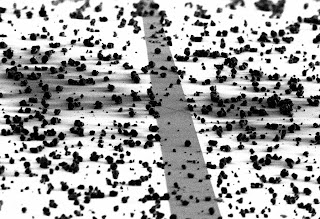Contamination
,What often happens during the fabrication process of nano-devices is that the sample gets some kind of contamination. It can be either dust, some nano- or micro-particles or organic compounds, such as polymers... Very often this contamination can be seen only in microscope (optical or sem), but still it can affect the devices!
How to avoid contamination? The best choice is to work in a clean environment, in a lab called clean-room. They typically have a controlled amount of dust in the air (for example 12 particles per cubic meter of 0.3 μm and smaller ) and also constant temperature and humidity. This prevents dust from acumulating on the samples. To get rid of organic stuff it is best to use strong solvents, such as acetone or DCE for instance.
However, it still can happen that despite all the precautions the sample ends up dirty. Example below!!!
Particles cover all the sample surface
Close view
Halloween special ;)








